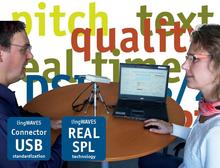Description
lingWAVES Voice Protocol – the easy standard voice assessment
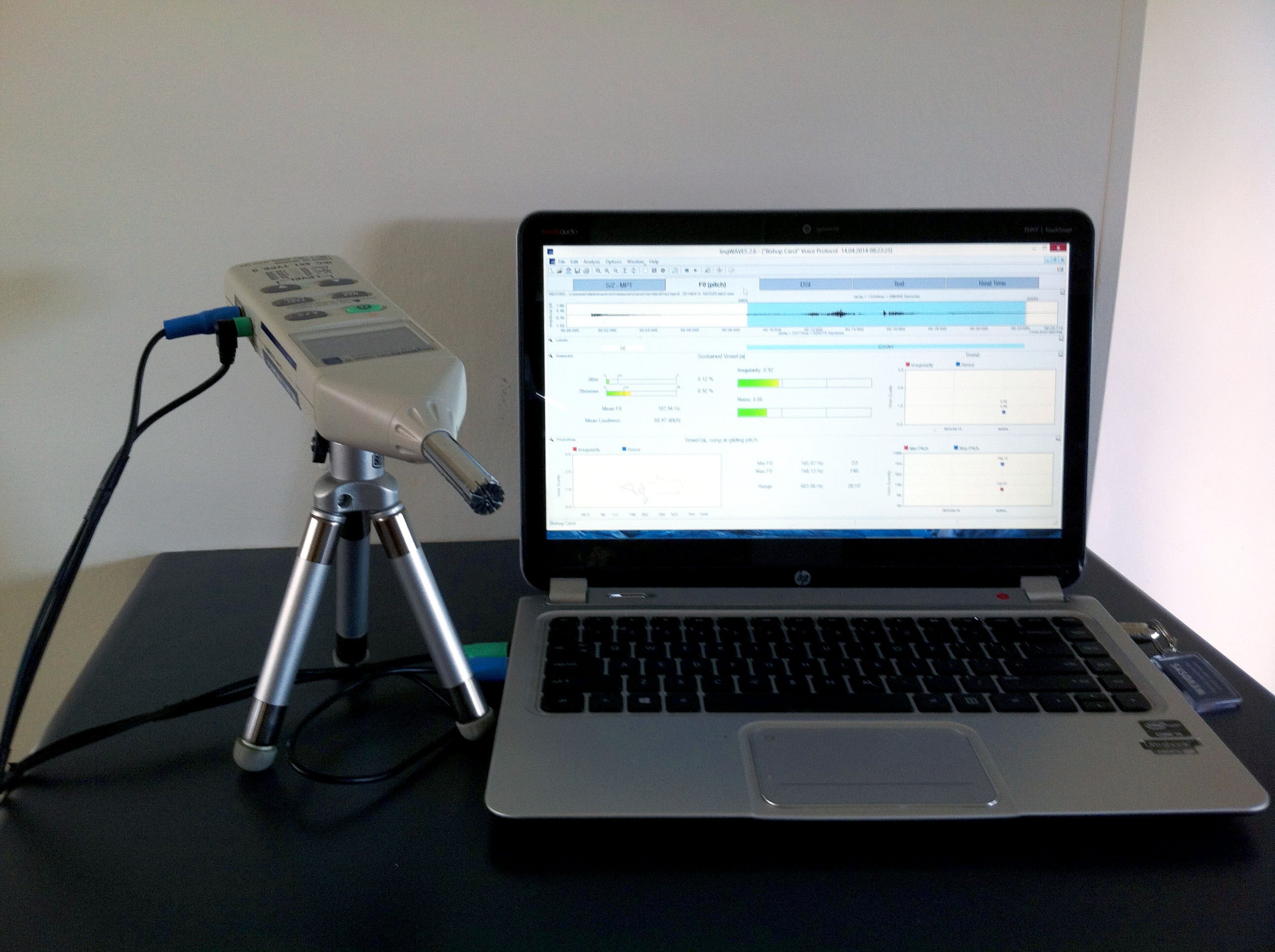
Standard Voice Assessment Protocol
Revolutionary and Unique – a quick and easy 10 minute Standard voice assessment protocol – gives reliable and objective measures for voice assessment tasks used worldwide.
A must – have for every clinic – whether you are a voice specialist or only see an occasional voice or Parkinsons client. Saves time in gathering and analysing data instantaneously and provides a clear instant printed report including progress tracking and outcomes.

- Screen 1 – s/z ratio, MPT (Maximum Phonation Time)
- Screen 2 – F0 / pitch, loudness, glide, voice quality, jitter, shimmer, irregularity, noise (GNE)
- Screen 3 – DSI (Dysphonia Severity Index)
- Screen 4 – Spoken Text Analysis – Pitch and SPL range in running speech
- Screen 5 – optional screen for your own preferred assessment tasks and client biofeedback and performance measures for treatment sessions
But that’s not all:
1. VP Voice assessment data is clearly displayed and most results are compared with norm data. A graphical and numerical display allows easy interpretation of the results at first glance.

2. Track progress and outcomes – Make several pre-post voice assessments during your treatment. lingWAVES VP shows results of all client sessions on a time line.
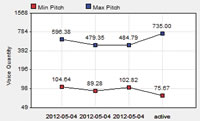
3. Use real time pitch and loudness display for biofeedback, e.g. if you treat Parkinson patients.

4. It doesn’t matter what recording hardware and sound card you have – lingWAVES VP comes with a certified SPL meter / microphone and a plug-and-play lingWAVES Connector USB, with its own sound card. You can compare results from different computers – calibration is not necessary. All you need is a recent Windows XP, Vista, 7 or 8 computer.
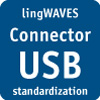
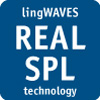
2 minutes for step 2: Record and label a 3 seconds sustained vowel and perform a glide from your lowest to highest pitch.
A quick Vospector measurement provides instant data of jitter, shimmer and the new objective measurements related to perception – irregularity (roughness) and noise (breathiness), compared with norm data and displayed on a session time line.
Step 1: s/z Ratio and Maximum Phonation Time (MPT)
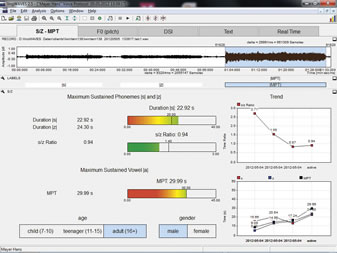
3 minutes for step 1: Record and label s, z and MPT and get instant results compared with norm data and displayed on a time line with other client sessions (e.g. for pre post assessment analysis)
The s/z Ratio is an indicator of voice disorder. It measures the ability to sustain the voiceless sound ‘s’ in comparison to sustaining the voiced sound ‘z’. 95% of people who have some difficulty affecting the function of their vocal cords have an s/z ratio of greater than 1.40. This article demonstrates how an s/z Ratio is normally calculated and how to interpret the result. (lingWAVES VP does this for you). Read more ….
Maximum Phonation Time (MPT) is a useful measure of vocal function. It is quick and easy to administer and provides a simple test of glottic efficiency. This article describes how to calculate MPT and how to interpret MPT results. – lingWAVES VP does this instantly.
Step 2: F0-Pitch Analysis
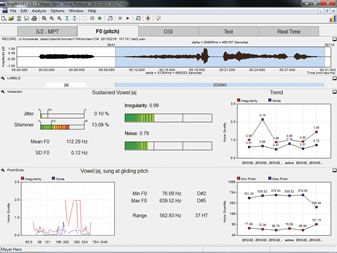
2 minutes for step 2: Record and label a 3 seconds sustained vowel and perform a glide from your lowest to highest pitch.
A quick Vospector measurement provides instant data of jitter, shimmer and the new objective measurements related to perception – irregularity (roughness) and noise (breathiness), compared with norm data and displayed on a session time line.
View a pdf explaining the Norms used in lingWAVES Voice Protocol
NEW: lingWAVES introduces a new pitch glide analysis – voice quality as a function of fundamental frequency /pitch to show vocal fold regularity of movement and vocal fold closure.
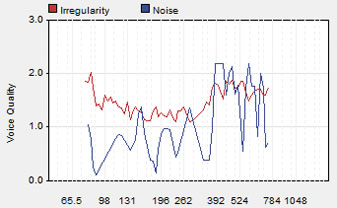
Pitch, in speech is how high or low a tone is perceived by the ear. This depends on the number of vibrations per second – fundamental frequency (F0) – produced by the vocal cords. Pitch is the main acoustic correlate of tone and intonation.
lingWAVES Voice Protocol gives instant data on Fundamental Frequency, minimum pitch (Hz) and corresponding musical note, Max Pitch (Hz) and corresponding musical note, pitch range in Hz and semitones.
Step 3: Dysphonia Severity Index (DSI)

1 minute for step 3: All you need now for a DSI calculation is the client’s minimum loudness. Highest Frequency, MPT and Jitter are already measured in steps 1 and 2. Just record a sustained vowel [a:] from normal to lowest loudness. The display shows a time line for DSI, jitter and highest pitch and lowest loudness.
The vocal quality and degree of dysphonia of a client is modeled by means of a Dysphonia Severity Index (DSI), which is designed to establish an objective and quantitative correlate of the perceived vocal quality. DSI is based on a multidimensional approach and not only based on a single acoustic measurement (e.g. cepstral analysis, jitter, …) and therefore more close t o perceptual evaluation.
View a pdf explaining the Norms used in lingWAVES Voice Protocol
Table showing the way lingWAVES DSI scores are classified into impairment levels (for further information see pdf explanation above)
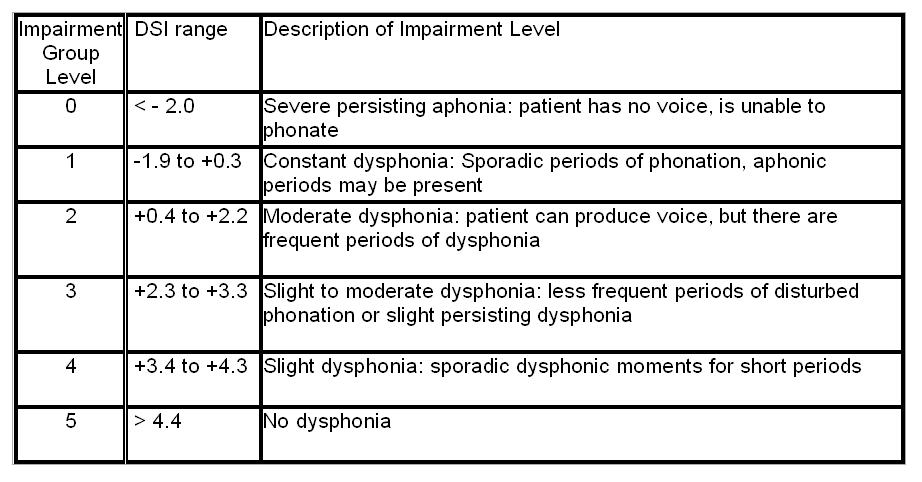
Step 4: Spoken Text Analysis
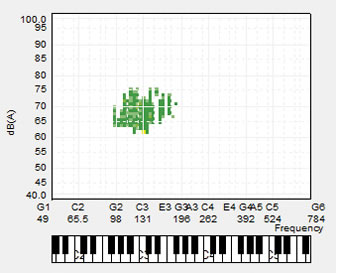
3 minutes for step 4: Record a standard text (Rainbow Passage) which is shown on the screen during recording of your client. Pitch and loudness data are displayed instantly after reading completion.
NEW: Frequency and absolute loudness (dB) data are displayed in a frequency/loudness graph, comparable with a VRP (Voice Range Profile). This graph provides a better and easier to understand overview.
VP spoken text analysis is a voice analysis of continuous speech with fundamental frequency and absolute loudness measurements. It gives information about the mean fundamental frequency / SPL loudness as well as pitch range and Dynamic range.
Step 4+ extra display: + Real Time Pitch and Loudness
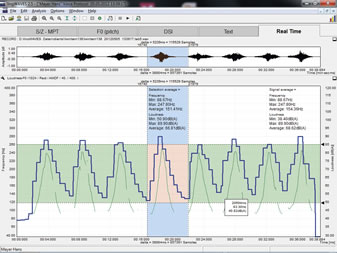
Optional extra display for objective display of?duration, pitch and loudness (SPL) measures for objective measurement in your own preferred assessments or for visual biofeedback in treatment sessions such as Parkinsons client biofeedback. It provides a visual biofeedback of loudness and pitch characteristics of a patient’s voice / speech and can also display a target loudness level to enhance a patient’s self-perception and motivation.
Great for Parkinsons as it displays Pitch and SPL loudness and duration on the same screen.
Perfect if you use CAPE-V
The CAPE-V indicates salient perceptual vocal attributes, identified by the core consensus group as commonly used and easily understood. The attributes are: (a) Overall Severity; (b) Roughness; (c) Breathiness; (d) Strain; (e) Pitch; and (f) Loudness.
lingWAVES Voice Protocol provides 4 of 6 objective measured CAPE-V data.
The Consensus Auditory-Perceptual Evaluation of Voice (CAPE-V) was developed as a tool for clinical auditory-perceptual assessment of voice. Its primary purpose is to describe the severity of auditory-perceptual attributes of a voice problem, in a way that can be communicated among clinicians. Its secondary purpose is to contribute to hypotheses regarding the anatomic and physiological bases of voice problems and to evaluate the need for additional testing.
Clearly arranged pdf report
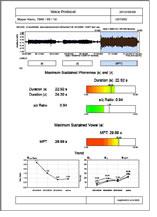
All results of the lingWAVES Voice Protocol are presented in a clearly arranged and understandable on-screen display and printed report. A time line function presents an overview about pre-post analysis.
The use of lingWAVES recording hardware with a certified sound level meter-microphone offers highly reliable and comparable results including comparisons of recordings between different computers.
lingWAVES Sets with Voice Protocol
The lingWAVES Voice Protocol can be purchased as a suite with voice recording, Client Manager, spectrography and VDI / VHI-12 module.
It is also included within the lingWAVES Voice Clinic Suite Pro set
It can also be bought bundled with lingWAVES SLP Suite Pro (ask for lingWAVES – SLP Suite Pro VPR Set ). This is a great value set for general clinics as it includes the Standard Voice Protocol plus recording, patient management, extended biofeedback including Theravox games, real time spectrography, standard and extended voice analysis, hoarseness assessment, motor speech assessment plus the new Connector USB with its own Sound Card and SPL Meter Microphone.
System Requirements:
- OS: Windows 10
( Mac OS with Boot Camp and installed Windows OS 10) - Hardware: min. Core i5, min. 8 GB RAM (recommended 16 GB RAM, min.16 GB RAM for video modules[strobo/endo/FEES]), 500 GB hard disk space for data (smartENDOSTROBO 1TB – external USB 3.0 hard disk possible), speaker, 1 – 2 x USB (smartENDOSTROBO powered USB recommended)
Warranty and Support:
WEVOSYS provides a 2 year Manufacturer Warranty for all hardware.
WEVOSYS also provides free software updates, email support and remote support for 3 years from purchase.
Multimedia Speech Pathology can also provide basic support and instructions.
Contact us and include your dongle number and Computer Operating System.
Or fill in the request form for support from WEVOSYS
International Remote Support is available here
Research Articles Using lingWAVES

